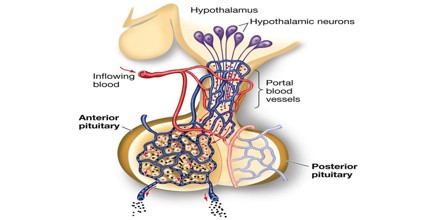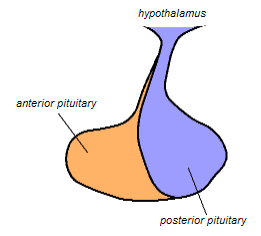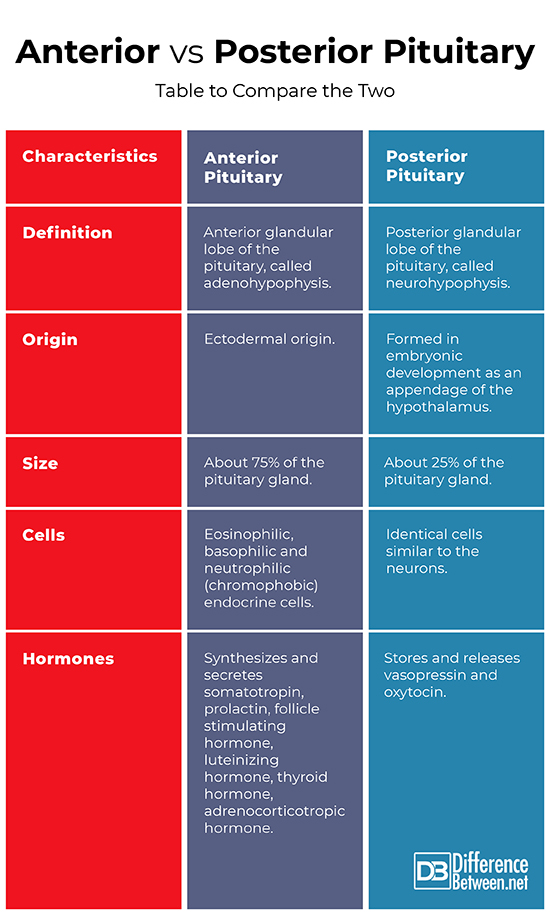Difference Between Anterior Pituitary and Posterior Pituitary
The pituitary gland is a small endocrine organ. It is located in a saddle-shaped depression in the body of the sphenoid bone of the human skull called sella turcica (Turkish saddle). The pituitary gland is connected to the hypothalamus.
The pituitary is isolated from the bone wall of the skull with a thick, dense layer of connective tissue.
It has an oval shape. Its dimensions are: length: 12-15 mm, width: 8-10 mm, height: 5-6 mm.
In terms of weight, it shows large individual differences. In men, pituitary weighs an average of 0.6 g. In women, during pregnancy, it increases and after birth does not return to its original size. Therefore, in women with several children, it can weigh more than 1 g.
The gland is divided into two parts:
- Anterior pituitary;
- Posterior pituitary.
The two pituitary units have a different cellular structure and supply the body with different hormones.
What is Anterior Pituitary?
The anterior glandular lobe of the pituitary gland is called adenohypophysis. It is about 75% of the gland. The anterior pituitary has an ectodermal origin.
The anterior pituitary is built up of several types of endocrine cells with different affinity for colorants:
- Eosinophilic cells – colored by acidic coloring agents;
- Basophilic cells – colored by basic coloring agents;
- Neutrophilic (chromophobic) cells – have no affinity for coloring agents.
Eosinophilic and basophilic cells synthesize and secrete hormones. The neutrophilic cells are “backup cells” that, if necessary, undergo a maturation process and differentiate into eosinophilic or basophilic cells.
The anterior lobe of the pituitary synthesizes and secretes the so-called tropic hormones. These are hormones that have other endocrine glands as their target and do not directly regulate processes in the body.
Anterior pituitary produces the following hormones:
- Somatotropin – human growth hormone;
- Prolactin – regulates the development of the breasts and the lactation;
- Follicle stimulating hormone – regulates ovarian follicle growth in women and spermatogenesis in men;
- Luteinizing hormone – causes ovulation and yellow body formation in women, and the release of testosterone in men;
- Thyroid hormone – stimulates the function of the thyroid gland;
- Adrenocorticotropic hormone – stimulates the production of hormones in the adrenal gland.
What is Posterior Pituitary?
The posterior glandular lobe of the pituitary gland is called neurohypophysis. It is about 25% percent of the gland.
It is formed in embryonic development as an appendage of the hypothalamus.
The posterior pituitary is built up of identical cells similar to the neurons. The cells are connected to the hypothalamic neurons through long axons. While the anterior pituitary cells synthesize certain hormones that are secreted into the blood, in the posterior pituitary hormones are not synthesized. The posterior pituitary stores and releases two hormones. They are synthesized in the hypothalamus.
These hormones are:
- Vasopressin – antidiuretic hormone, stimulates the absorption of water in the curved kidney tubules, resulting in primary urine thickening, and constricting blood vessels, resulting in increased blood pressure;
- Oxytocin – acts on the smooth muscles of the uterus, stimulates their contraction.
Difference Between Anterior and Posterior Pituitary
-
Definition
Anterior Pituitary: Anterior pituitary is the anterior glandular lobe of the pituitary called adenohypophysis.
Posterior Pituitary: Posterior pituitary is the posterior glandular lobe of the pituitary called neurohypophysis.
-
Origin
Anterior Pituitary: The anterior pituitary has an ectodermal origin.
Posterior Pituitary: The posterior pituitary is formed in embryonic development as an appendage of the hypothalamus.
-
Size
Anterior Pituitary: The anterior pituitary is about 75% of the gland.
Posterior Pituitary: The posterior pituitary is about 25% of the gland.
-
Cells
Anterior Pituitary: The anterior pituitary is built up of eosinophilic, basophilic and neutrophilic (chromophobic) endocrine cells.
Posterior Pituitary: The posterior pituitary is built up of identical cells similar to the neurons.
-
Hormones
Anterior Pituitary: The anterior pituitary synthesizes and secretes somatotropin, prolactin, follicle stimulating hormone, luteinizing hormone, thyroid hormone, adrenocorticotropic hormone.
Posterior Pituitary: The posterior pituitary stores and releases vasopressin and oxytocin.
Anterior vs Posterior Pituitary : Table to compare the Two
Summary of Anterior verses Posterior Pituitary:
- The pituitary gland is a small endocrine organ, located in a saddle-shaped depression in the body of the sphenoid bone of the human skull called sella turcica.
- The pituitary gland is divided into anterior and posterior pituitary. The two pituitary units have a different cellular structure and supply the body with different hormones.
- Anterior pituitary is the anterior glandular lobe of the pituitary, called adenohypophysis.
- Posterior pituitary is the posterior glandular lobe of the pituitary, called neurohypophysis.
- The anterior pituitary has an ectodermal origin. The posterior pituitary is formed in embryonic development as an appendage of the hypothalamus.
- The anterior pituitary is about 75%, and the posterior pituitary is about 25% of the gland.
- The anterior pituitary is built up of eosinophilic, basophilic and neutrophilic (chromophobic) endocrine cells.
- The posterior pituitary is built up of identical cells similar to the neurons.
- The anterior pituitary synthesizes and secretes somatotropin, prolactin, follicle stimulating hormone, luteinizing hormone, thyroid hormone, adrenocorticotropic hormone. The posterior pituitary does not synthesize hormones, it stores and releases vasopressin and oxytocin.
- Difference Between Gallstones and Cholecystitis - September 5, 2021
- Difference Between Constipation and Cramping - August 4, 2021
- Difference Between Whole Genome Sequencing and Microarray - May 6, 2021
Search DifferenceBetween.net :
Leave a Response
References :
[0]Arzt, E., M. Bronstein, M. Guitelman. The Pituitary Today - Molecular, Physiological and Clinical Aspects. Basel: Karger Medical and Scientific Publishers. 2006. Print.
[1]Hinson, J., P. Raven, S. Chew. The Endocrine System: Systems of the Body Series 2nd Edition. London: Churchill Livingstone. 2010. Print.
[2]Melmed, S. (Ed.). The Pituitary. 4th Edition. Cambridge: Academic Press. 2017. Print.
[3]Image credit: http://www.assignmentpoint.com/wp-content/uploads/2017/06/Anterior-Pituitary0.jpg
[4]Image credit: https://en.wikipedia.org/wiki/Posterior_pituitary#/media/File:Pituitary_gland_representation.PNG



